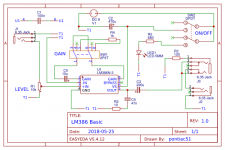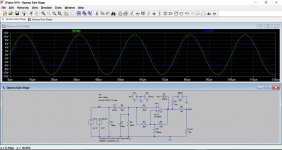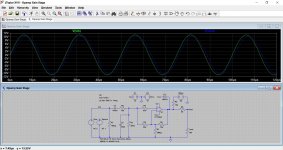The LED is easy, just get a super high efficiency one such as:
http://cpc.farnell.com/broadcom-limited/hlmp-d155/led-5mm-red/dp/SC11586?st=LED
The distortion really needs a scope to see what is actually happening and whether the amp is clipping (lack of headroom) or doing something odd like breaking into instability and oscillation. Increasing the supply a little as a test is worth trying.
http://cpc.farnell.com/broadcom-limited/hlmp-d155/led-5mm-red/dp/SC11586?st=LED
The distortion really needs a scope to see what is actually happening and whether the amp is clipping (lack of headroom) or doing something odd like breaking into instability and oscillation. Increasing the supply a little as a test is worth trying.
The 47nF on the IN did nothing for me. But raising the supply voltage to 12V nearly got rid of the crackles, they are far less dominant now. What is this and why is it happening? Or even better, can I get rid of it?
I used a power supply this time and noticed some hum or fizz. Could I counter that with a 100nF on Pin7?
And I changed the 120R on the headphone ground back to a 10R. Of course this is much louder now, it's on the brink of being to loud at full power.
I also changed the LED resistor to a 2.2k, which still is enough to light it.
I used a power supply this time and noticed some hum or fizz. Could I counter that with a 100nF on Pin7?
And I changed the 120R on the headphone ground back to a 10R. Of course this is much louder now, it's on the brink of being to loud at full power.
I also changed the LED resistor to a 2.2k, which still is enough to light it.
It sounds like the amp is running out of steam and clipping. That means the output voltage is trying to go beyond the limits of the power supply.
This shows a simple opamp buffer running on -/+9 volts and being fed an 11 volt peak signal. It clips. Now we raise the supply to -/+15 and its all good.
You could try a cap from pin 7 to ground. Perhaps something a bit bigger such as a 10uF electrolytic. Try what you have though, there are no hard and fast rules for that.
This shows a simple opamp buffer running on -/+9 volts and being fed an 11 volt peak signal. It clips. Now we raise the supply to -/+15 and its all good.
You could try a cap from pin 7 to ground. Perhaps something a bit bigger such as a 10uF electrolytic. Try what you have though, there are no hard and fast rules for that.
Attachments
I've never studied the differences tbh but the N4 seems to be rated to 18 volts as against 12 volt for the others.
For 9 volt operation into a speaker (and headphone) the N3 looks the best bet. For higher voltage operation into a higher impedance load (headphone amp) the N4 looks best.
A preamp wont overcome issues of overloading, in fact it would probably make things worse.
For 9 volt operation into a speaker (and headphone) the N3 looks the best bet. For higher voltage operation into a higher impedance load (headphone amp) the N4 looks best.
A preamp wont overcome issues of overloading, in fact it would probably make things worse.
Ok, then I will have to make this tradoff. I really want to stay on 9V.
Yes, I thought this could happen. But, considering I only want to drive the LM386 fully because this gives nice distortion (rolled back to 80% there is nearly none even if at 200x GAIN), a preamp with it's own distortion/clipping could solve that, couldn't it?
Yes, I thought this could happen. But, considering I only want to drive the LM386 fully because this gives nice distortion (rolled back to 80% there is nearly none even if at 200x GAIN), a preamp with it's own distortion/clipping could solve that, couldn't it?
I'm not 100% clear on what you are trying to do here 
Are you saying you want the distortion to appear at lower levels ? If so then that is a whole different ball game and you want something that 'soft clips'. The TL071 opamp would hard clip when the output hit the rail voltage limit (actually quite a bit below that because the TL071 isn't capable of swinging fully between the rails when used on low voltage).
Are you saying you want the distortion to appear at lower levels ? If so then that is a whole different ball game and you want something that 'soft clips'. The TL071 opamp would hard clip when the output hit the rail voltage limit (actually quite a bit below that because the TL071 isn't capable of swinging fully between the rails when used on low voltage).
Ok, currently I have an amp that I can distort nicely with the GAIN switch, but only if the volume is quite near maximum. Of course the effect is greatly reduced when rolling off the volume pot on the amp or the guitar. Which means I cannot have this nice gain tones when using headphones, because the amp can't drive them without clipping.
So, I thought to have an preamp (or is this rather an effect then?) which does quite the same so I do not run into clipping issues on the power amp. The benefit would be to have high gain tones at low volume.
What would happen if i run dual LM386s (in paralell) like in the Little Gem Mk2?
So, I thought to have an preamp (or is this rather an effect then?) which does quite the same so I do not run into clipping issues on the power amp. The benefit would be to have high gain tones at low volume.
What would happen if i run dual LM386s (in paralell) like in the Little Gem Mk2?
Paralleling the chips (it has to be done correctly to allow them to share equally) allows more current delivery into a load. It does not in itself increase voltage swing unless the limits of voltage swing were being limited by trying to deliver to much current into the load... if that makes sense.
This might sound illogical but try adding a small (0.5 or 1 watt) resistor as a dummy load even when using headphones. Something like a 6.8 ohm to simulate a speaker loading.
Connect it from the output side (negative) of C3 to ground. That will make the chip work much harder and so distort earlier when using headphones.
Is that the effect you want ?
This might sound illogical but try adding a small (0.5 or 1 watt) resistor as a dummy load even when using headphones. Something like a 6.8 ohm to simulate a speaker loading.
Connect it from the output side (negative) of C3 to ground. That will make the chip work much harder and so distort earlier when using headphones.
Is that the effect you want ?
May be another option would be simple signal limiter on the input...
AMZ-FX Guitar Effects Blog >> Blog Archive Diode Clipping Switch - AMZ-FX Guitar Effects Blog
AMZ-FX Guitar Effects Blog >> Blog Archive Diode Clipping Switch - AMZ-FX Guitar Effects Blog
I am still not sure wheter your crackling is electronic (chipamp clipping or oscillating) or mechanical (too much bass for littgle open air headphones or plain dead/damaged headphones.
Have you tried another known good pair there?
Your signal gain is already too high and a preamp will only worsen that.
I have used tons of LM386, from headphone drivers to "Smokey" type guitar amps, to reverb tank drivers to alarms to step up/down/reverse polarity voltage converters, very versatile.
I noticed many newbies have problems with them oscillating, it *might* be the case here, or they simply clip because they hit rails (although that is usually deafening with headphones).
Have you tried another known good pair there?
Your signal gain is already too high and a preamp will only worsen that.
I have used tons of LM386, from headphone drivers to "Smokey" type guitar amps, to reverb tank drivers to alarms to step up/down/reverse polarity voltage converters, very versatile.
I noticed many newbies have problems with them oscillating, it *might* be the case here, or they simply clip because they hit rails (although that is usually deafening with headphones).
I have used tons of LM386, from headphone drivers to "Smokey" type guitar amps, to reverb tank drivers to alarms to step up/down/reverse polarity voltage converters, very versatile.
I used one to build a speaker testing tool way back in high school. Oscillator + 386 = cheap and dirty tool for designing and testing speakers. All parts came from Radio Shack.
It still works (40+years old) and I used it a couple years ago when I built my 8" two ways. I need to build a better one.
The 1W 8Ohms on the OUT and the signal limiter on the IN (I hooked up two LEDs) just let everything crackle more. But I guess that was to be expected. Yes, I tried that one after the other.
I'm sure the headphones are fine and yes I have tried different ones (ever more ohms) and that sounded the same. Breakups and crackles as soon as I went over 80% on the volume dial. It sounds like an overdriven speaker, but this also happens when I up the headphone resistor. It gets quieter, but the breakups are still there. So, I am sure its not the headphones.
The voltage on the ouput pin checks out at 3.87V with 7.75V overall powered up.
I'm sure the headphones are fine and yes I have tried different ones (ever more ohms) and that sounded the same. Breakups and crackles as soon as I went over 80% on the volume dial. It sounds like an overdriven speaker, but this also happens when I up the headphone resistor. It gets quieter, but the breakups are still there. So, I am sure its not the headphones.
The voltage on the ouput pin checks out at 3.87V with 7.75V overall powered up.
Last edited:
- Status
- This old topic is closed. If you want to reopen this topic, contact a moderator using the "Report Post" button.
- Home
- Amplifiers
- Chip Amps
- Lost on LM386



